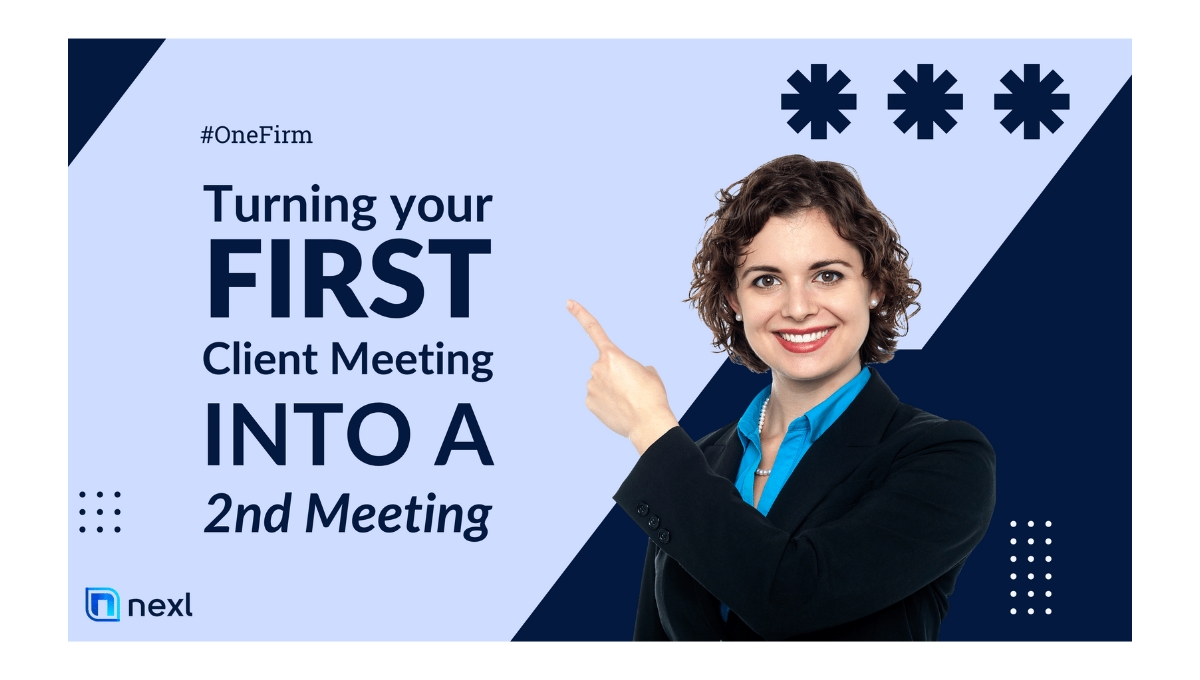As a lawyer, meeting with potential clients is one of your most important tasks. Too often, lawyers put so much time into getting meetings with their clients and prospective clients, yet the meeting falls flat. According to Ben Paul, the Director and Founder of The BD Ladder, it’s essential to make a good impression. Ben’s philosophy is to ensure that the client sees long-term benefits in a relationship with you.
In this blog, Ben Paul discusses how lawyers can master their first client meetings to ensure they lead to another meeting. Ben has countless years of experience consulting in the Professional Services industry. We will take a deeper dive into the facets of a successful first client meeting by understanding:
1 – The problems lawyers face when conducting client meetings
2 – The 3 facets of the meeting process
3 – How Nexl can help manage first client meetings

The Problems Lawyers Face When Conducting Client Meetings
Common questions posed by lawyers before heading into their first client meetings are, “How do I get the next meeting after this initial contact?” or “How do I get another meeting once I have completed the work?”
Law firms need to know their clients—they need to see them from a broader perspective. This will allow the lawyers to add value to their clients beyond the work that has been completed. Lawyers need to know what is important to their clients and what their clients are looking for. This will enable the firm to offer services that fit the client’s profile. The main aim for lawyers during their first client meeting is to identify how their firm can aid the client in both the short and long term.
The 3 facets of the meeting process
There are 3 parts to a first client meeting: (1) the preparation before the meeting, (2) the actual meeting and how to conduct it, and (3) the post-meeting actions. Let’s walk through each piece should look like for a successful first client meeting.
(1) Meeting Preparation – always be prepared!
Before meeting with any potential clients, it’s important to be prepared. Make sure you understand the client’s specific legal needs and be ready to answer questions about those needs. Research their background to know as much as possible about the client’s business dealings.
Once you understand the client’s potential needs, lay out the meeting on an agenda and send it to the client before the meeting, with an overview of all the related services you may be able to offer. When sending the agenda, ask the client to respond and add their own talking points. This will filter out clients who aren’t interested in what the firm is offering and spotlight those who are serious about engaging. The aim is to have a premeditated purpose you want to achieve. The goal is to ensure everything discussed is geared towards achieving that agreed purpose.
The most common assumption that lawyers make before stepping into a meeting is that they need to have a well-crafted pitch ready. Unfortunately, that is incorrect! The lawyer must know what services their law firm has to offer but needs to step into the meeting with an open mind, and let the information learned drive the proposal.
(2) During the Meeting – listen carefully
Listening is just as important—if not more important—as talking during these meetings. Lawyers need to pay attention to what their potential client is saying and how they’re saying it. Their body language, facial expressions, and the words they use are important. This will help you to better understand what the client’s pain points are, and what their expectations are for working together in the future. By listening carefully, lawyers can ensure that the meeting is purpose-led while keeping the client’s needs top of mind.
Here the meeting agenda reveals its true importance because it keeps the conversation on track. The agenda leads to the identification of 2 to 3 shared actions. It is important that these actions are of equal value for the law firm and the client. This creates buy-in from the client, shifting the mindset. The mindset is now, “we are here to help each other” rather than “I am here to sell you something and take your money.”
To identify shared actions, the lawyer must listen carefully to the potential client. The client will share their aspirations and where they aim to go. The lawyer must always ask the client what help the client wants before the firm offers a solution. Building relationships with potential clients is key to securing future business opportunities.
(3) After the Meeting – closing the deal
At the end of every client meeting, the lawyer should close off the meeting by sending an email summary of the meeting in bullet point format. Furthermore, the email should outline the next steps and include all important dates (such as when the law firm will send over any documentation that the client asked for, or when they can expect to hear results from any follow-up research about their inquiries). The next steps should include all actions required from both parties. Importantly, the conversation should remain open. The email should end by asking the client to add any points that you might have missed, or questions that may have occurred to them after the meeting.
It is essential that the client and the lawyer have taken away something useful from the discussion. Both parties need to know their next steps moving forward. This could include scheduling follow-up calls, sending documents, or agreeing on deadlines. By doing this, the conversation of a second meeting will arise naturally. The client commits to providing the lawyer with something of value and the lawyer commits to being the receiver.
How Nexl can help manage first client meetings
Nexl is a three-part system: no-data-entry CRM, relationship intelligence (ERM), and revenue operations. Nexl automatically captures all of your lawyers’ interactions. Any email sent or received and any meetings with clients, prospective clients, or referral sources are automatically captured, analysed, and turned into actionable insights to help you accelerate your revenue growth.
Lawyers must understand the entire relationship history of prospective and existing clients. They need to understand who knows whom across the entire firm and across every client relationship. Nexl shows deep relationship insights that can be used to better leverage connections and win more business.
Nexl has key features that are critical to knowing and understanding clients’ needs and aspirations, and proactively nurturing the client relationship.
(a) WHO KNOWS WHO INTELLIGENCE:
Nexl’s automatic data capture instantly captures and maps every interaction. This allows everyone in the firm to better understand who knows whom, across clients, prospective clients, and shared third-party contacts.
(b) STAY-IN-TOUCH REMINDERS:
With Nexl’s stay-in-touch reminders, lawyers don’t forget to follow up with individual contacts, and relationships across companies are seamlessly tracked and maintained. By staying proactive and regularly reaching out to clients, law firms create better client relationships and keep an open dialogue—allowing them to identify even more potential business opportunities.
Conclusion
Preparing for and having successful meetings with clients can help build strong relationships. This can lead to further opportunities down the line. By creating an agreed purpose beforehand and focusing on generating shared actions post-meeting, you can ensure that each conversation leads you closer to long-term success.
If you want to learn more about how Nexl can support your law firm to turn relationships into revenue, click the “Request Demo” button below!










